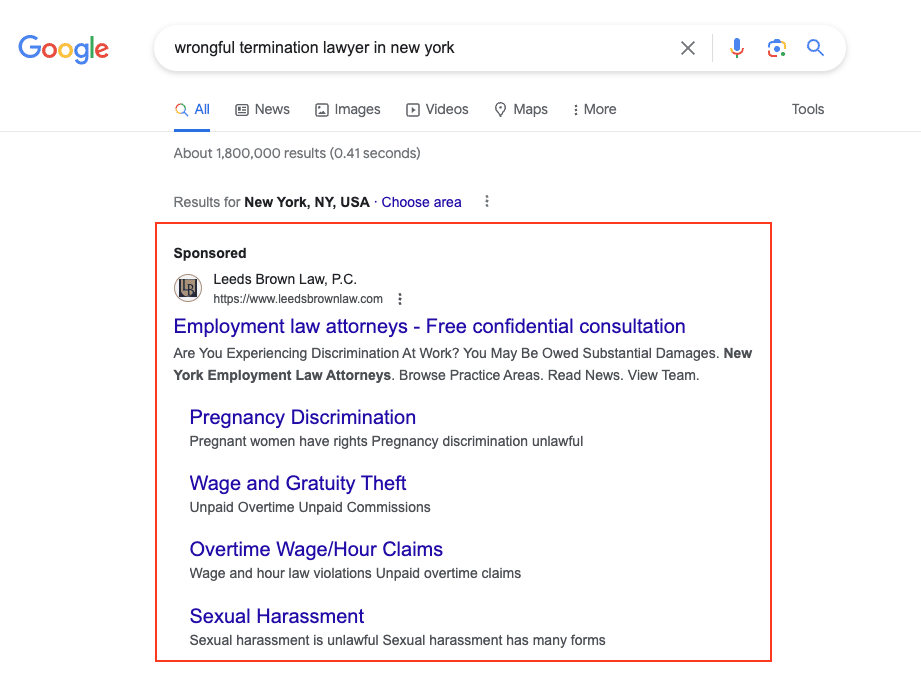Law Firm Advertising: 2025 Beginner’s Guide + Examples
What is Law Firm Advertising?
Law firm advertising is when law firms promote their practice on digital and traditional advertising platforms with the goal of attracting potential clients and generating leads. It’s an important component of any law firm marketing plan.
Getting Started With Lawyer Advertising
Lawyer advertising is an integral part of a legal marketing campaign. The purpose of running these ads can vary, but it is ultimately designed for attracting potential clients (lead generation) and revenue growth.
As opposed to free law firm marketing methods like referral and networking, lawyer advertising can bring faster and measurable results. At On The Map Marketing, we refer to our lawyer ads service packages as instant traction.
To get started, you’ll need to follow certain steps to ensure you achieve your goals with the right strategy.
Understand Your Audience
Before you can create legal advertising content, you’ll need to understand and identify your ideal viewers. Your target audience will depend on your practice area. For instance, a family lawyer’s audience will be different from a personal injury law firm’s audience.
Identifying your target audience helps you create relevant ads that speak to them and, as a result, can bring you quality leads and better conversions.
You can conduct your audience research by:
- Looking at your current clients’ demographics
- Looking at your competitors’ audience
- Creating multiple client personas
- Conducting surveys and interviews
- Use data from previous cases, marketing campaigns, and website analytics
When you have a clear idea of your audience, you can create compelling content, attract the right people and get high-converting leads.
Establish Your Lawyer Marketing Strategy
Having an advertising strategy is essential in helping you focus on your marketing goals and implement the necessary steps to achieve them. To come up with a successful law firm marketing campaign, you’ll need to keep your strategy clear.
Are you using paid advertising to enhance your search engine optimization (SEO) efforts? What is the goal of your ad campaigns?
No matter your business goal, you should have a solid plan on how to achieve it. Make sure you have this strategy written down and that everyone on your team is on board with it and are working together with this in mind.
Read The American Bar Association Guidelines On Lawyer Advertising
The American Bar Association (ABA) has rules when it comes to lawyers and law firms advertising their services (online or offline).
Some of these rules include:
- Not make false claims or guarantees
- Not compensate clients in exchange for positive client reviews
- Not claim to be certified unless there is proof
For the rest of these guidelines, you’ll need to refer to the ABA Rule 7.2: Communications Concerning a Lawyer’s Services.
Set Advertising Goals
Think about the advertising methods you want to do and whether they are the best option to achieve your goal. Here are some of the goals you would have when promoting your legal services (online or offline):
- Driving website traffic
- Generating high-quality leads
- Increasing sales or getting new clients
- Brand awareness
Some methods, like print advertising (newspapers, billboards, etc.) are best used when your goal is brand awareness. These ads are not expected to drive traffic to your law firm website or bring you more leads (directly).
Settle on an Advertising Budget
You would need to decide how much of your marketing budget you should allocate to advertising. Generally, law firms invest between 5 – 20% of their revenue in marketing. This amount should be divided into the different marketing activities you plan to implement in a year.
Track Your Advertising Efforts and Iterate Your Ads
Tracking and measuring your ad’s performance is crucial to knowing whether they are working or not. Most specifically, tracking performance is essential to understand key advertising metrics like:
- Impressions: Number of times your ad was shown
- Clicks: Number of times people clicked on your ad
- CTR (Click-through rate): Number of clicks on your ads divided by impressions
- CPC (Cost per click): The average amount you pay every time someone clicks on your ad.
- Conversion rate: The number/percentage of people who took your call to action (CTA) after clicking on your ad. A good conversion rate is 2% and above.
- Return on investment (ROI): The gain (or loss) of an investment relative to its cost. It can be computed as: (Gain/Investment Cost) x 100%.
Analyzing your advertising campaign’s performance will help you make the necessary changes needed for a better law firm marketing strategy if needed.
6 Types of Law Firm Advertising Examples
There are different types of advertising that you can use for your legal practice. Here is a brief discussion of some of the most common types of law firm advertising using digital and traditional channels.
Video Advertising
Video advertising is when companies use videos to promote a product or service. These are commonly seen in video-sharing platforms like Facebook, Instagram, YouTube, and TikTok. Video ads can be the video content itself or as another video (labeled as an ad) that plays within an app (in-app video ads), like YouTube.
Print Advertising
Print advertising are ads that are seen in print media (newspapers, magazines, and brochures). Also included in this category are direct mail, billboards, and posters. Print ads for law firms often include the firm’s name, location, practice area, pricing, and contact information.
TV and Radio Ads
TV and radio ads (also known as commercials) appear in between television and radio programs. These ads are ideal for reaching a large audience and staying “top of mind” for people who might remember the product or service at a later time.
Billboards
A type of print advertising, billboards are big, outdoor advertising structures seen along highways and anywhere that there is a huge crowd (mostly in cities). Billboards help companies reach thousands of people and build brand awareness and recognition.
Social Media Ads
Social media advertising involves the firm ads on social media platforms such as Facebook, Instagram, Twitter, and LinkedIn. These ads can be a part of a bigger social media marketing plan and are made to achieve a goal such as website visits, sales, and other conversion campaigns.
Certain channels like Facebook Ads allow advertisers to target audiences by location, interests, and other demographic factors.
Search Engine Advertising
Search engine advertising, also called PPC (pay-per-click) ads, appear on top of search engine results (like Google Search) and are marked as “Sponsored”. The most common type of search engine advertising provider is Google Ads. The image shown below is an example of a search engine ad for the search term “wrongful termination lawyer in New York”.

Google Ads allow advertisers to bid on ad spots for a specific keyword and charge advertisers per ad click. PPC ad costs can vary depending on your law practice, with personal injury and family law being more competitive and costly as compared to other practice areas like estate planning.
How Much Should Law Firms Budget on Advertising?
Your law firm’s advertising budget will depend on a few factors including:
- Your priority goal. What’s the most important goal to you? This will determine where you spend most of your budget.
- Your firm’s current visibility online. How is your website performance? Are you ranking on Google’s first page for target keywords? How many visits are you getting per month?
- Your practice area. Some practice areas like personal injury and family law are quite competitive, so you might need a bigger budget than other firms.
- Historical data. If you have run marketing campaigns before, you can look at the data and see which ones brought you closer to your business goals.
Having a law firm marketing budget prevents you from overspending and helps you be resourceful and creative while staying within your means.
Which Type of Lawyer Advertising is The Best For Lawyers?
There is not one advertising type that fits all law firms. This will depend on your law firm’s size, practice area, budget, location, and target audience.
A small law firm with a modest budget might not have the resources to run a print ad campaign, but can benefit more with Google Ads and social media ads. Alternatively, multi-location firms might afford more lucrative advertising campaigns like print, TV, and radio.
Your audience can also be a factor in choosing an advertising method. If you’re targeting a younger demographic, you might find better results with social media ads.
Lastly, you can also choose a traditional or modern approach that fits your firm’s brand.
The type of advertising you choose should make sense for your brand, your audience, your goals, and your budget.
Digital Advertising vs. Traditional Ads
Advertising your law firm online and offline both has its benefits and disadvantages. It’s important to consider these when deciding which method you want to focus on.
Digital Advertising or Online Advertising
Pros:
- The ability to target an audience and reach
- The ability to measure results
- Cost-effective
- The ability to interact with your audience and potential clients
- You can pause and revise your ads and change the content of your ad’s landing pages
Cons:
- High competition
- Some people don’t like ads on their online content and use ad blockers
- Ads require technical skills to set up and maintain
- People have privacy concerns with their data
Traditional Advertising
Pros:
- Massive reach
- Creates lasting impression with repeated exposure
- Perceived credibility
- Tangible presence makes ad more impactful
Cons:
- Cannot target specific audiences
- Challenging to track and measure
- High cost
- Cannot make changes to your ad once published
In a nutshell, digital ads are great for targeting a specific audience while traditional advertising offers massive reach and better brand recall.
Start Your Digital Marketing and Advertising With Us Today!
If you want to ensure that your marketing efforts result in attracting prospective clients and growing your online presence, you can get help from On The Map Marketing.
We have years of experience in helping law firms get new leads from successful advertising campaigns along with other marketing tactics like search engine optimization (SEO), content marketing, and web design.
Get in touch with us today to get started with your custom law firm advertising plan.
Table of Contents
Related Articles
Dominate Your Market with Digital Marketing Services That Deliver
Talk to a certified professional today, and we will design a strategy specific to your case.






